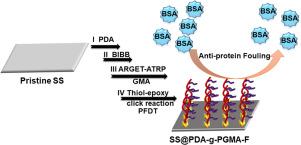Reactive & Functional Polymers ( IF 4.5 ) Pub Date : 2021-07-07 , DOI: 10.1016/j.reactfunctpolym.2021.104974 Lin Chen 1 , Lin Li 1 , Xu Zhao 1 , Shuangshuang Wang 1 , Yuchao Li 1 , Guang Li 1 , Xiangcai Ge 1 , Liping Wang 1

|
In this work, fluorine containing polymer brushes was grafted on the functionalized stainless steel (SS) by activators regenerated by electron transfer atom transfer radical polymerization (ARGET-ATRP) and thiol-epoxy click reaction. PGMA brushes would be grafted on SS by coating the sheets with brominated polydopamine (PDA) as a reactive under-layer, and subsequently surface-initiate ARGET-ATRP of glycidyl methacrylate (GMA). Then the short-fluorinated alkyl chains were anchored on the PGMA backbones based on the click reaction between epoxy groups of PGMA and 1H, 1H, 2H, 2H-perfluorodecanethiol (PFDT), which endowed the surfaces of the polymers with low surface free energy. The surface compositions and morphologies of the functionalized SS have been characterized by attenuated total reflection-Fourier transform infrared (ATR-FTIR) spectroscopy, X-ray photoelectron spectroscopy (XPS), scanning electron microscope (SEM) and atomic force microscopy (AFM). The results of water contact angle analysis exhibited high hydrophobicity of the fluorinated polymer grafting modified SS surface. Bovine serum albumin (BSA) resistance performance of the functionalized SS was evaluated by BCA protein assay reagent, fluorescence microscope and XPS. The results exhibited that grafting fluoropolymer brushes modified SS with lower protein adsorption compared with the pristine SS surface, which might be served as promising environmentally friendly polymer antifouling coatings.
中文翻译:

通过电子转移ATRP和硫醇-环氧点击反应再生的活化剂构建防污氟化聚合物刷
在这项工作中,通过电子转移原子转移自由基聚合(ARGET-ATRP)和硫醇-环氧树脂点击反应再生的活化剂将含氟聚合物刷接枝在功能化不锈钢(SS)上。PGMA 刷将通过用溴化聚多巴胺 (PDA) 作为反应性底层涂覆片材,然后表面引发甲基丙烯酸缩水甘油酯 (GMA) 的 ARGET-ATRP 来接枝在 SS 上。然后基于 PGMA 的环氧基团与 1H、1H、2H、2H-全氟癸硫醇 (PFDT) 之间的点击反应将短氟化烷基链锚定在 PGMA 主链上,从而赋予聚合物表面低表面自由能。功能化 SS 的表面组成和形态已通过衰减全反射傅里叶变换红外 (ATR-FTIR) 光谱表征,X 射线光电子能谱 (XPS)、扫描电子显微镜 (SEM) 和原子力显微镜 (AFM)。水接触角分析结果表明,氟化聚合物接枝改性SS表面具有高疏水性。通过BCA蛋白测定试剂、荧光显微镜和XPS评估功能化SS的牛血清白蛋白(BSA)抗性性能。结果表明,与原始 SS 表面相比,接枝含氟聚合物刷改性的 SS 具有更低的蛋白质吸附性,可作为有前景的环保聚合物防污涂料。水接触角分析结果表明,氟化聚合物接枝改性SS表面具有高疏水性。通过BCA蛋白测定试剂、荧光显微镜和XPS评估功能化SS的牛血清白蛋白(BSA)抗性性能。结果表明,与原始 SS 表面相比,接枝含氟聚合物刷改性的 SS 具有更低的蛋白质吸附性,可作为有前景的环保聚合物防污涂料。水接触角分析结果表明,氟化聚合物接枝改性SS表面具有高疏水性。通过BCA蛋白测定试剂、荧光显微镜和XPS评估功能化SS的牛血清白蛋白(BSA)抗性性能。结果表明,与原始 SS 表面相比,接枝含氟聚合物刷改性的 SS 具有更低的蛋白质吸附性,可作为有前景的环保聚合物防污涂料。











































 京公网安备 11010802027423号
京公网安备 11010802027423号